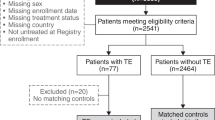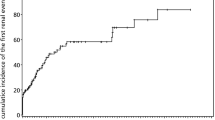Abstract
Paroxysmal nocturnal hemoglobinuria (PNH) is an acquired hemolytic disease with thrombosis as a major complication. The mechanism of thrombosis and related risk factors in PNH patients are still not well characterized. We retrospectively enrolled 99 patients with newly diagnosed PNH at our institute from 2011 to 2016. According to binary logistic regression model analysis, we first identified four baseline clinical risk factors which may be associated with incidence of thrombosis in the PNH cohort, including PNH clone sizes (fluorescent aerolysin of neutrophil) ≤ 80 (OR 1.056, 95%CI 1.016–1.097, P = 0.005), hemoglobin ≤ 75 g/L (OR 4.202, 95%CI 0.984–17.954, P = 0.053), platelet > 100 × 109/L (OR 6.547, 95%CI 1.490–28.767, P = 0.013) and rs495828 = G (OR 5.243, 95%CI 1.314–20.916, P = 0.019). These independent risk factors were combined together to develop a risk model to evaluate thrombosis risk (AUC = 0.756, 95%CI 0.607–0.905, P < 0.001). Our risk model revealed a higher cumulative incidence of thrombosis and an earlier thrombosis events in PNH patients with high risk (risk score ≥ 23) compared with those with low risk (risk score < 23, P < 0.001 and P = 0.043, respectively). Although with some limitations, we set up a prediction model for thrombosis risk in patients with PNH for the first time, but it needed to be verified in a prospective study with larger patients and longer follow-up time in the future.


Similar content being viewed by others
Change history
15 November 2019
The authors determined an error in the affiliation section; it was captured as Department of Hematology, Peking Union Hospital, CAMS & PUMC, Beijing 100,730, China. The correct affiliation should be Department of Hematology, Peking Union Medical College Hospital, Chinese Academy of Medical Science and Peking Union Medical College, Beijing, 100730, China.
References
Hill A, DeZern AE, Kinoshita T, Brodsky RA (2017) Paroxysmal nocturnal haemoglobinuria. Nat Rev Dis Primers 3:17028. https://doi.org/10.1038/nrdp.2017.28
Mohammed AA, El-Tanni H, Atiah TA, Atiah AA, Atiah MA, Rasmy AA (2016) Paroxysmal nocturnal hemoglobinuria: from bench to bed. Indian J Hematol Blood Transfus 32(4):383–391. https://doi.org/10.1007/s12288-016-0654-2
Boyce S, Eren E, Lwaleed BA, Kazmi RS (2015) The activation of complement and its role in the pathogenesis of thromboembolism. Semin Thromb Hemost 41(6):665–672. https://doi.org/10.1055/s-0035-1556732
Schrezenmeier H, Muus P, Socie G, Szer J, Urbano-Ispizua A, Maciejewski JP, Brodsky RA, Bessler M, Kanakura Y, Rosse W, Khursigara G, Bedrosian C, Hillmen P (2014) Baseline characteristics and disease burden in patients in the international paroxysmal nocturnal hemoglobinuria registry. Haematologica 99(5):922–929. https://doi.org/10.3324/haematol.2013.093161
Day ISCWT (2014) Thrombosis: a major contributor to global disease burden. Thromb Res 134(5):931–938. https://doi.org/10.1016/j.thromres.2014.08.014
Hill A, Kelly RJ, Hillmen P (2013) Thrombosis in paroxysmal nocturnal hemoglobinuria. Blood 121(25):4985–4996. https://doi.org/10.1182/blood-2012-09-311381
DeZern AE, Brodsky RA (2015) Paroxysmal nocturnal hemoglobinuria: a complement-mediated hemolytic anemia. Hematol Oncol Clin North Am 29(3):479–494. https://doi.org/10.1016/j.hoc.2015.01.005
Griffin M, Munir T (2017) Management of thrombosis in paroxysmal nocturnal hemoglobinuria: a clinician’s guide. Ther Adv Hematol 8(3):119–126. https://doi.org/10.1177/2040620716681748
Ziakas PD, Poulou LS, Rokas GI, Bartzoudis D, Voulgarelis M (2007) Thrombosis in paroxysmal nocturnal hemoglobinuria: sites, risks, outcome. An overview. J Thromb Haemost 5(3):642–645. https://doi.org/10.1111/j.1538-7836.2007.02379.x
Hillmen P, Muus P, Duhrsen U, Risitano AM, Schubert J, Luzzatto L, Schrezenmeier H, Szer J, Brodsky RA, Hill A, Socie G, Bessler M, Rollins SA, Bell L, Rother RP, Young NS (2007) Effect of the complement inhibitor eculizumab on thromboembolism in patients with paroxysmal nocturnal hemoglobinuria. Blood 110(12):4123–4128. https://doi.org/10.1182/blood-2007-06-095646
de Latour RP, Mary JY, Salanoubat C, Terriou L, Etienne G, Mohty M, Roth S, De GS, Maury S, Cahn JY (2008) Paroxysmal nocturnal hemoglobinuria: natural history of disease subcategories. Blood 112(8):3099–3106
Brodsky RA (2014) Paroxysmal nocturnal hemoglobinuria. Blood 124(18):2804–2811. https://doi.org/10.1182/blood-2014-02-522128
Hoekstra J, Leebeek FW, Plessier A, Raffa S, Darwish Murad S, Heller J, Hadengue A, Chagneau C, Elias E, Primignani M, Garcia-Pagan JC, Valla DC, Janssen HL (2009) European network for vascular disorders of the L (2009) paroxysmal nocturnal hemoglobinuria in Budd-Chiari syndrome: findings from a cohort study. J Hepatol 51(4):696–706. https://doi.org/10.1016/j.jhep.2009.06.019
Long Z, Du Y, Li H, Han B (2017) Polymorphism of the ABO gene associate with thrombosis risk in patients with paroxysmal nocturnal hemoglobinuria. Oncotarget 8(54):92411–92419. https://doi.org/10.18632/oncotarget.21361
Dezern AE, Borowitz MJ (2018) ICCS/ESCCA consensus guidelines to detect GPI-deficient cells in paroxysmal nocturnal hemoglobinuria (PNH) and related disorders part 1 - clinical utility. Cytometry B Clin Cytom 94(1):16–22. https://doi.org/10.1002/cyto.b.21608
Borowitz MJ, Craig FE, Digiuseppe JA, Illingworth AJ, Rosse W, Sutherland DR, Wittwer CT, Richards SJ, Clinical Cytometry S (2010) Guidelines for the diagnosis and monitoring of paroxysmal nocturnal hemoglobinuria and related disorders by flow cytometry. Cytometry B Clin Cytom 78(4):211–230. https://doi.org/10.1002/cyto.b.20525
Sullivan LM, Massaro JM, Sr D'Agostino RB (2004) Presentation of multivariate data for clinical use: the Framingham study risk score functions. Stat Med 23(10):1631–1660. https://doi.org/10.1002/sim.1742
Lee JW, Jang JH, Kim JS, Yoon SS, Lee JH, Kim YK, Jo DY, Chung J, Sohn SK (2013) Clinical signs and symptoms associated with increased risk for thrombosis in patients with paroxysmal nocturnal hemoglobinuria from a Korean registry. Int J Hematol 97(6):749–757. https://doi.org/10.1007/s12185-013-1346-4
Nishimura J, Kanakura Y, Ware RE, Shichishima T, Nakakuma H, Ninomiya H, Decastro CM, Hall S, Kanamaru A, Sullivan KM, Mizoguchi H, Omine M, Kinoshita T, Rosse WF (2004) Clinical course and flow cytometric analysis of paroxysmal nocturnal hemoglobinuria in the United States and Japan. Medicine 83(3):193–207
Helley D, de Latour RP, Porcher R, Rodrigues CA, Galy-Fauroux I, Matheron J, Duval A, Schved JF, Fischer AM, Socie G, French Society of H (2010) Evaluation of hemostasis and endothelial function in patients with paroxysmal nocturnal hemoglobinuria receiving eculizumab. Haematologica 95(4):574–581. https://doi.org/10.3324/haematol.2009.016121
Kinoshita S, Iida H, Inoue S, Watanabe K, Kurihara M, Wada Y, Tsuda H, Kang D, Hamasaki N (2005) Protein S and protein C gene mutations in Japanese deep vein thrombosis patients. Clin Biochem 38(10):908–915. https://doi.org/10.1016/j.clinbiochem.2005.05.006
Yu F, Du Y, Han B (2016) A comparative analysis of clinical characteristics of patients with paroxysmal nocturnal hemoglobinuria between Asia and Europe/America. Int J Hematol 103(6):649–654. https://doi.org/10.1007/s12185-016-1995-1
Zou N, Han B, Cai H, Xu Y, Wang X, Li RS, Shen T (2012) Clinical features of 76 Chinese patients with paroxysmal nocturnal haemoglobinuria. Zhonghua xue ye xue za zhi = Zhonghua xueyexue zazhi 33(6):471–474
Ge M, Li X, Shi J, Shao Y, Zheng Y (2012) Clinical features and prognostic factors of Asian patients with paroxysmal nocturnal hemoglobinuria: results from a single center in China. Ann Hematol 91(7):1121–1128. https://doi.org/10.1007/s00277-012-1413-6
Green M, Styles T, Russell T, Sada C, Jallow E, Stewart J, Lazariashvili O, Lubomirova I, Cotlarciuc I, Sharma S, Han TS, Sharma P (2018) Non-genetic and genetic risk factors for adult cerebral venous thrombosis. Thromb Res 169:15–22. https://doi.org/10.1016/j.thromres.2018.07.005
Taran LD (2003) Protein C system and thrombosis diseases. Ukr Biokhim Zh (1999) 75(1):18–24
Peacock-Young B, Macrae FL, Newton DJ, Hill A, Ariens RAS (2018) The prothrombotic state in paroxysmal nocturnal hemoglobinuria: a multifaceted source. Haematologica 103(1):9–17. https://doi.org/10.3324/haematol.2017.177618
Blair P, Flaumenhaft R (2009) Platelet alpha-granules: basic biology and clinical correlates. Blood Rev 23(4):177–189. https://doi.org/10.1016/j.blre.2009.04.001
Wiedmer T, Esmon CT, Sims PJ (1986) Complement proteins C5b-9 stimulate procoagulant activity through platelet prothrombinase. Blood 68(4):875–880
Du Y, Long Z, Xie H, Zhuang J, Han B (2016) The preliminary research in paroxysmal nocturnal hemoglobinuria with thrombosis. Zhonghua xue ye xue za zhi = Zhonghua xueyexue zazhi 37(4):318–323. https://doi.org/10.3760/cma.j.issn.0253-2727.2016.04.014
Hosmer DW, Hosmer T, Le Cessie S, Lemeshow S (1997) A comparison of goodness-of-fit tests for the logistic regression model. Stat Med 16(9):965–980
Van Bijnen ST, Van Heerde WL, Muus P (2012) Mechanisms and clinical implications of thrombosis in paroxysmal nocturnal hemoglobinuria. J Thromb Haemost 10(1):1–10. https://doi.org/10.1111/j.1538-7836.2011.04562.x
Morange PE, Suchon P, Tregouet DA (2015) Genetics of venous thrombosis: update in 2015. Thromb Haemost 114(5):910–919. https://doi.org/10.1160/TH15-05-0410
Funding
This study was supported by grants from the Chinese Academy of Medical Sciences (CAMS) innovation fund for medical sciences (2016-I2M-3-004), The National Key Research and Development Program of China (2016YFC0901500), and Beijing Natural Science Foundation (7192168).
Author information
Authors and Affiliations
Contributions
Y.H. and B.H. designed the study and wrote the manuscript. Y.H. analyzed clinical and experimental data. X.L. helped analyzed the risk model. C.Y. and M.C. helped to design the study. Z.L. and W.Z. collected the samples, performed genotyping, and helped to analyze the data. H.L. and F.C. helped to perform genotyping. All authors reviewed the manuscript finally. Y.H., M.C., and B.H. approved the final submission of the manuscript.
Corresponding author
Ethics declarations
Conflict of interest
The authors declare that they have no conflict of interest.
Research involving human participants
All procedures performed in studies involving human participants were in accordance with the ethical standards of the institutional and/or national research committee and with the 1964 Helsinki declaration and its later amendments or comparable ethical standards. The study was approved by the PUMCH Ethics Committee.
Informed consent
Informed consent was obtained before study start from all individuals included in the study.
Additional information
Publisher’s note
Springer Nature remains neutral with regard to jurisdictional claims in published maps and institutional affiliations.
Rights and permissions
About this article
Cite this article
Huang, Y., Liu, X., Chen, F. et al. Prediction of thrombosis risk in patients with paroxysmal nocturnal hemoglobinuria. Ann Hematol 98, 2283–2291 (2019). https://doi.org/10.1007/s00277-019-03770-3
Received:
Accepted:
Published:
Issue Date:
DOI: https://doi.org/10.1007/s00277-019-03770-3




